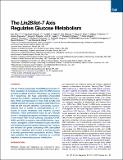The Lin28/let-7 Axis Regulates Glucose Metabolism
Author(s)
Zhu, Hao; Shyh-Chang, Ng; Segrè, Ayellet V.; Shinoda, Gen; Shah, Samar P.; Einhorn, William S.; Takeuchi, Ayumu; Engreitz, Jesse Michael; Hagan, John P.; Kharas, Michael G.; Urbach, Achia; Thornton, James E.; Triboulet, Robinson; Gregory, Richard I.; Altshuler, David; Daley, George Q.; ... Show more Show less
DownloadZhu-2011-The Lin28_let-7 Axis.pdf (1.358Mb)
PUBLISHER_POLICY
Publisher Policy
Article is made available in accordance with the publisher's policy and may be subject to US copyright law. Please refer to the publisher's site for terms of use.
Terms of use
Metadata
Show full item recordAbstract
The let-7 tumor suppressor microRNAs are known for their regulation of oncogenes, while the RNA-binding proteins Lin28a/b promote malignancy by inhibiting let-7 biogenesis. We have uncovered unexpected roles for the Lin28/let-7 pathway in regulating metabolism. When overexpressed in mice, both Lin28a and LIN28B promote an insulin-sensitized state that resists high-fat-diet induced diabetes. Conversely, muscle-specific loss of Lin28a or overexpression of let-7 results in insulin resistance and impaired glucose tolerance. These phenomena occur, in part, through the let-7-mediated repression of multiple components of the insulin-PI3K-mTOR pathway, including IGF1R, INSR, and IRS2. In addition, the mTOR inhibitor, rapamycin, abrogates Lin28a-mediated insulin sensitivity and enhanced glucose uptake. Moreover, let-7 targets are enriched for genes containing SNPs associated with type 2 diabetes and control of fasting glucose in human genome-wide association studies. These data establish the Lin28/let-7 pathway as a central regulator of mammalian glucose metabolism.
Date issued
2011-09Department
Harvard University--MIT Division of Health Sciences and TechnologyJournal
Cell
Publisher
Elsevier B.V.
Citation
Zhu, Hao, Ng Shyh-Chang, Ayellet V. Segrè, Gen Shinoda, Samar P. Shah, William S. Einhorn, Ayumu Takeuchi, et al. “The Lin28/let-7 Axis Regulates Glucose Metabolism.” Cell 147, no. 1 (September 2011): 81–94. © 2014 Elsevier B.V.
Version: Final published version
ISSN
00928674